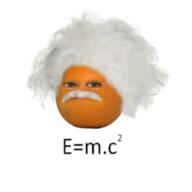chem reaction
2010-07-24 5:11 am
methybenzene同cyclohexane react with bromine water都form two layered solution:upper layer係orange,lower layer係yellow,點解會有呢2種colour?
回答 (2)
2010-07-24 8:35 am
✔ 最佳答案
Methylbenzene and cyclohexane are non-polar organic solvents. These two non-polar organic solvents (methylbenzene and cyclohexane) are immiscible with water, which is the solvent of bromine water. The non-polar organic solvent (methylbenzene or cyclohexane) is in excess in the reaction. Therefore, the organic layer (the excess non-polar organic solvent) and the aqueous layer form two layers. As both the densities of methylbenzene and cyclohexane are less than water, the upper layer is the organic layer (methylbenzene or cyclohexane) while the bottom layer is the aqueous layer.甲基苯和環己烷是非極性有機溶劑。這兩個非極性有機溶劑(甲基苯和環己烷)與溴水的溶劑——水並不互溶。這兩個非極性有機溶劑(甲基苯或環己烷)在反應中是過量的。因此,有機層(過量的非極性有機溶劑)與水形成兩層。由於甲基苯和環己環兩者的密度均怟於水,故上層為機層,而下層為水層。
Bromine can dissolves in both the organic layer (methylbenzene or cyclohexane) and water. Bromine dissolves in non-polar organic solvents to form an orange solvent, while dissolves in water to form a yellow solution. (The colour of the yellow aqueous layer is paler than common brown bromine water because bromine is more soluble in organic solvents and thus only a small portion of bromine dissolves in water.) Therefore, the upper organic layer is orange, while the bottom aqueous layer is yellow.
溴可溶於有機層(甲基苯和環己烷)和水。溴溶於非性有機溶劑形成橙色溶液,而溶於水形成黃色溶液。(與常見的褐色溴水比較,黃色的溴水的顏色較淺。這是因為溴較溶於有機溶劑,只有少量的溴溶於水。)故此,上層的有機層為橙色,而下層的水層為黃色。
2010-07-24 00:59:21 補充:
沒問題啦,大家也答得不錯,看運氣吧!
參考: andrew
2010-07-24 8:38 am
Methylbenzene + Br2(l) à no reactionCyclohexane + Br2(l) à no reaction Bromine water, its colour, is brown in colour in aqueous solution. Br2 molecules are non-polarà dissolve more readily in organic solvents than that of aqueous solutionà diffuse from the aqueous layer to organic layer(similar principle to solvent extraction)à yellow colour in aqueous layer & orange colour in organic layer P.S. cyclohexane & methylbenzene is less dense than aqueous layerThus, upper layer is orange in colour & lower layer is yellow in colour.
2010-07-24 00:41:15 補充:
一禁完回答
估唔到比你快我一步 =]
2010-07-24 00:41:15 補充:
一禁完回答
估唔到比你快我一步 =]
參考: 撼頭埋牆
收錄日期: 2021-04-13 17:23:09
原文連結 [永久失效]:
https://hk.answers.yahoo.com/question/index?qid=20100723000051KK01585

